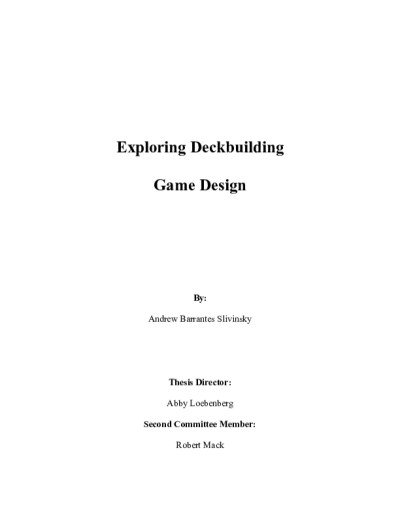Exploration of Game Design
- Author (aut): Gaumond, Timothy
- Thesis director: Loebenberg, Abby
- Committee member: Mack, Robert
- Contributor (ctb): Barrett, The Honors College
- Contributor (ctb): Department of Management and Entrepreneurship

The Greek myths are foundational to Western culture. To this day, school curriculums dedicate portions of their time to teaching the names of the Greek gods and studying Homer’s The Odyssey and Iliad. Outside of an academic setting, countless retellings of the Greek myths have been created for pure enjoyment purposes. Such stories have been marketed to a large range of audiences and have successfully gained world-wide recognition. This project aims to evaluate the mass appeal of the Greek myths as they are retold through Sigmund Freud’s theory of the death and life instincts. These theories manifest in a few different ways, each of which is evident in the genre of Greek myths retold. Utilizing six examples of Greek myth retellings, this project will demonstrate how the theories of the life and death instincts are active in the process of retellings an age-old story as well as how the retellings of the ancient Greek myths, specifically, demonstrate the manifestations of those instincts.
For my creative project, I designed an original board game. The game is titled Poise, and it is categorized as an abstract strategy game. Throughout the year, I researched board game design and experimented with game mechanics. The creative process of designing a new game was both challenging and exciting.
Color Theory is an abstract strategy game, a genre that emphasizes decision-making and strategic thinking without elements of luck or hidden information. This game utilizes primary and secondary colors to represent players' pieces, with the objective to move each player's pawns to the opposite same-colored spaces on the board. Developed through rigorous playtesting, Color Theory introduces a color ranking track that dictates the synergy between the move and jump actions. Players must strategically maneuver their pawns, while also taking into account the position of their colors on the ranking track. It strikes a balance between clever movement and player interaction, providing an accessible and enjoyable gaming experience. In the end, the first player to successfully move three of their six pawns to their opposite spaces wins the game.
This project analyzes the undying appeal for one of Avatar’s most notable characters: Prince Zuko. It discusses the already clear and established appeal for his character among fans. To complement this conscious appeal, it proposes there is an unconscious appeal for Zuko that the audience is unaware of. Using Kleinian theory discussing childhood development, there is a new angle of relatability that can be explored between viewers and Prince Zuko’s character. Specifically, Zuko experiences a shift and oscillation in Kleinian positions: the paranoid-schizoid and depressive positions. Zuko also demonstrates what Klein defines as seeking reparation. With this explanation, an unconscious perspective of appeal is revealed. This appeal is due to viewers relating to the struggles he endures because they lived through them as well.
Mind uploading is the process of uploading one’s consciousness into another entity, spanning across the internet or another body. This project analyzes the use of Freud’s theories of personality and his theories of the unconscious while understanding the appeal of mind uploading in two fantasy and dream-like films, Transcendence and Avatar. Mind uploading is a popularized concept with Transcendence and Avatar inspiring aspiring filmmakers and scientists with its imaginative and limitless qualities. Both films uniquely explore mind uploading with their own creative processes. The use of mind uploading in Transcendence highlights the blur between the realms of unconsciousness and consciousness, showing the destructive nature of mind uploading. In Avatar, mind uploading is shown as an evolutionary process in which the newfound unconscious has the potential to save and create new lives, giving characters within the film a second chance. These films reveal the interconnectedness of Freud’s theories of personality and how collaborative the mind can be to achieve a common goal.
For my thesis project, I joined a pathway course in Game Design. The goal was to design an analog game based upon principles learned in class and through experimental gameplay. Tasked with designing different game types and provided different styles of games to test, I was able to explore and develop my own game idea, Covers.